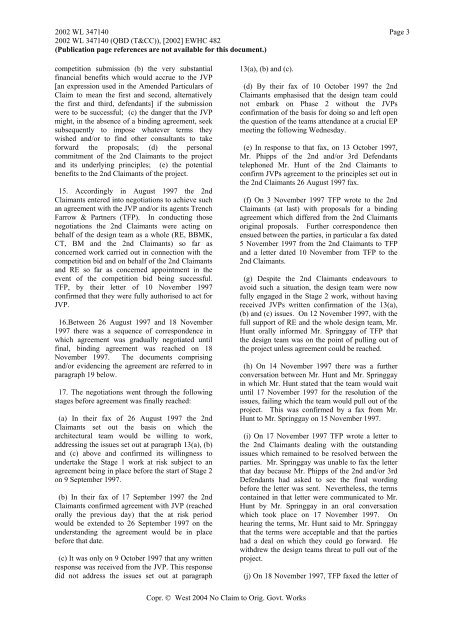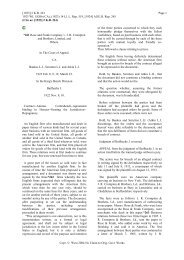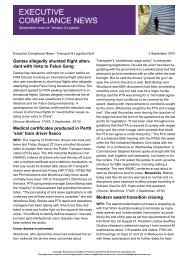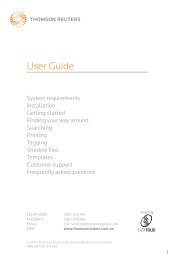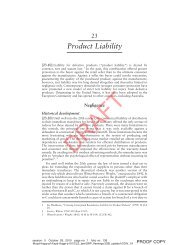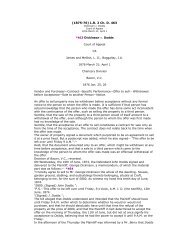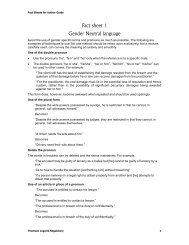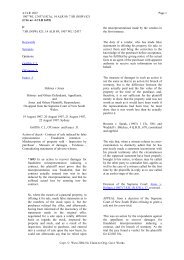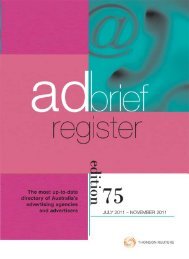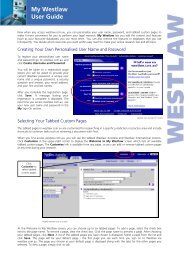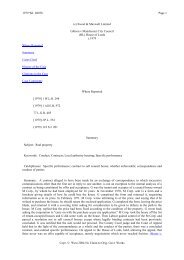Tesco v Constain - Thomson Reuters
Tesco v Constain - Thomson Reuters
Tesco v Constain - Thomson Reuters
Create successful ePaper yourself
Turn your PDF publications into a flip-book with our unique Google optimized e-Paper software.
2002 WL 347140 Page 32002 WL 347140 (QBD (T&CC)), [2002] EWHC 482(Publication page references are not available for this document.)competition submission (b) the very substantialfinancial benefits which would accrue to the JVP[an expression used in the Amended Particulars ofClaim to mean the first and second, alternativelythe first and third, defendants] if the submissionwere to be successful; (c) the danger that the JVPmight, in the absence of a binding agreement, seeksubsequently to impose whatever terms theywished and/or to find other consultants to takeforward the proposals; (d) the personalcommitment of the 2nd Claimants to the projectand its underlying principles; (e) the potentialbenefits to the 2nd Claimants of the project.15. Accordingly in August 1997 the 2ndClaimants entered into negotiations to achieve suchan agreement with the JVP and/or its agents TrenchFarrow & Partners (TFP). In conducting thosenegotiations the 2nd Claimants were acting onbehalf of the design team as a whole (RE, BBMK,CT, BM and the 2nd Claimants) so far asconcerned work carried out in connection with thecompetition bid and on behalf of the 2nd Claimantsand RE so far as concerned appointment in theevent of the competition bid being successful.TFP, by their letter of 10 November 1997confirmed that they were fully authorised to act forJVP.16.Between 26 August 1997 and 18 November1997 there was a sequence of correspondence inwhich agreement was gradually negotiated untilfinal, binding agreement was reached on 18November 1997. The documents comprisingand/or evidencing the agreement are referred to inparagraph 19 below.17. The negotiations went through the followingstages before agreement was finally reached:(a) In their fax of 26 August 1997 the 2ndClaimants set out the basis on which thearchitectural team would be willing to work,addressing the issues set out at paragraph 13(a), (b)and (c) above and confirmed its willingness toundertake the Stage 1 work at risk subject to anagreement being in place before the start of Stage 2on 9 September 1997.(b) In their fax of 17 September 1997 the 2ndClaimants confirmed agreement with JVP (reachedorally the previous day) that the at risk periodwould be extended to 26 September 1997 on theunderstanding the agreement would be in placebefore that date.(c) It was only on 9 October 1997 that any writtenresponse was received from the JVP. This responsedid not address the issues set out at paragraph13(a), (b) and (c).(d) By their fax of 10 October 1997 the 2ndClaimants emphasised that the design team couldnot embark on Phase 2 without the JVPsconfirmation of the basis for doing so and left openthe question of the teams attendance at a crucial EPmeeting the following Wednesday.(e) In response to that fax, on 13 October 1997,Mr. Phipps of the 2nd and/or 3rd Defendantstelephoned Mr. Hunt of the 2nd Claimants toconfirm JVPs agreement to the principles set out inthe 2nd Claimants 26 August 1997 fax.(f) On 3 November 1997 TFP wrote to the 2ndClaimants (at last) with proposals for a bindingagreement which differed from the 2nd Claimantsoriginal proposals. Further correspondence thenensued between the parties, in particular a fax dated5 November 1997 from the 2nd Claimants to TFPand a letter dated 10 November from TFP to the2nd Claimants.(g) Despite the 2nd Claimants endeavours toavoid such a situation, the design team were nowfully engaged in the Stage 2 work, without havingreceived JVPs written confirmation of the 13(a),(b) and (c) issues. On 12 November 1997, with thefull support of RE and the whole design team, Mr.Hunt orally informed Mr. Springgay of TFP thatthe design team was on the point of pulling out ofthe project unless agreement could be reached.(h) On 14 November 1997 there was a furtherconversation between Mr. Hunt and Mr. Springgayin which Mr. Hunt stated that the team would waituntil 17 November 1997 for the resolution of theissues, failing which the team would pull out of theproject. This was confirmed by a fax from Mr.Hunt to Mr. Springgay on 15 November 1997.(i) On 17 November 1997 TFP wrote a letter tothe 2nd Claimants dealing with the outstandingissues which remained to be resolved between theparties. Mr. Springgay was unable to fax the letterthat day because Mr. Phipps of the 2nd and/or 3rdDefendants had asked to see the final wordingbefore the letter was sent. Nevertheless, the termscontained in that letter were communicated to Mr.Hunt by Mr. Springgay in an oral conversationwhich took place on 17 November 1997. Onhearing the terms, Mr. Hunt said to Mr. Springgaythat the terms were acceptable and that the partieshad a deal on which they could go forward. Hewithdrew the design teams threat to pull out of theproject.(j) On 18 November 1997, TFP faxed the letter ofCopr. © West 2004 No Claim to Orig. Govt. Works


